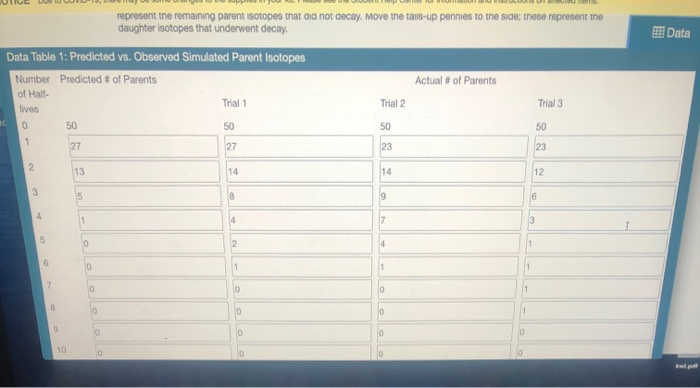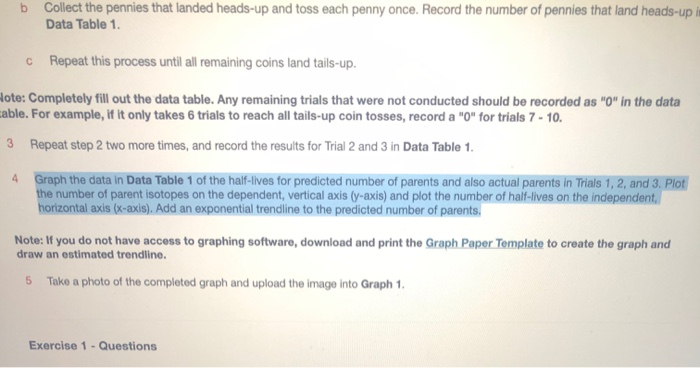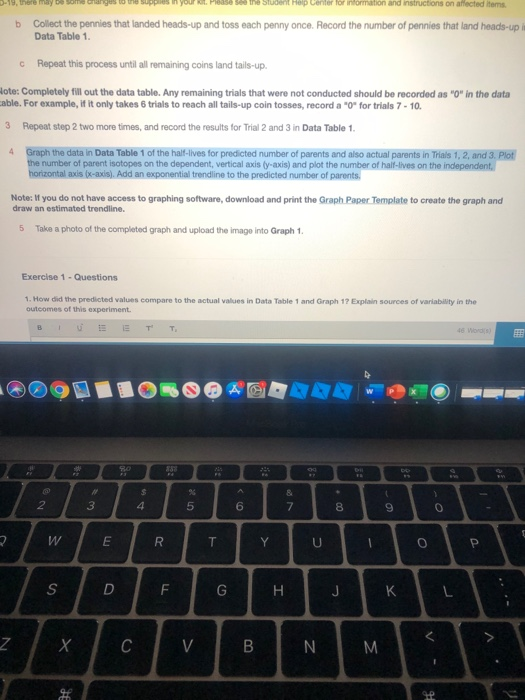
b Collect the pennies that landed heads-up and toss each penny once. Record the number of pennies that land heads-up i Data Table 1. c Repeat this process until all remaining coins land tails-up. Hote: Completely fill out the data table. Any remaining trials that were not conducted should be recorded as "0" in the data cable. For example, if it only takes 6 trials to reach all tails-up coin tosses, record a "0" for trials 7 - 10. 3 Repeat step 2 two more times, and record the results for Trial 2 and 3 in Data Table 1. 4 Graph the data in Data Table 1 of the half-lives for predicted number of parents and also actual parents in Trials 1, 2, and 3. Plot the number of parent isotopes on the dependent, vertical axis (y-axis) and plot the number of half-lives on the independent horizontal axis (x-axis). Add an exponential trendline to the predicted number of parents, Note: If you do not have access to graphing software, download and print the Graph Paper Template to create the graph and draw an estimated trendline. 5 Take a photo of the completed graph and upload the image into Graph 1. Exercise 1 - Questions Seine Student Map Center for information and instructions on affected Items b Collect the pennies that landed heads-up and toss each penny once. Record the number of pennies that land heads-up in Data Table 1. c Repeat this process until all remaining coins land tails-up. Hote: Completely fill out the data table. Any remaining trials that were not conducted should be recorded as "O" in the data cable. For example, if it only takes 6 trials to reach all tails-up coin tosses, record a "O" for trials 7 - 10. 3 Repeat step 2 two more times, and record the results for Trial 2 and 3 in Data Table 1. Graph the data in Data Table 1 of the half-lives for predicted number of parents and also actual parents in Trials 1, 2 and 3. Plot the number of parent isotopes on the dependent, vertical axis y-axis) and plot the number of half-lives on the independent, horizontal axis (x-axis). Add an exponential trendline to the predicted number of parents Note: If you do not have access to graphing software, download and print the Graph Paper Template to create the graph and draw an estimated trendline. 5 Take a photo of the completed graph and upload the image into Graph 1. 4 Exercise 1 - Questions 1. How did the predicted values compare to the actual values in Data Table 1 and Graph 1? Explain sources of variability in the outcomes of this experiment. B 1 18W NB $ 4 & 7 3 5 6 00 9 0 W E R T > U 0 S D F G I J K L v > Z C V B N. M FE Data represent the remaining parent isotopes that did not decay. Move the tails-up pennies to the side; these represent the daughter isotopes that underwent decay. Data Table 1: Predicted vs. Observed Simulated Parent Isotopes Number Predicted tof Parents Actual # of Parents Trial 1 Trial 2 Trial 3 of Hall lives 0 C 50 50 50 50 1 27 27 23 23 2 13 14 14 12 3 5 8 9 6 4 1 4 7 5 0 2 4 1 6 0 1 2 0 0 1 0 0 0 0 0 0 0 10 b Collect the pennies that landed heads-up and toss each penny once. Record the number of pennies that land heads-up i Data Table 1. c Repeat this process until all remaining coins land tails-up. Hote: Completely fill out the data table. Any remaining trials that were not conducted should be recorded as "0" in the data cable. For example, if it only takes 6 trials to reach all tails-up coin tosses, record a "0" for trials 7 - 10. 3 Repeat step 2 two more times, and record the results for Trial 2 and 3 in Data Table 1. 4 Graph the data in Data Table 1 of the half-lives for predicted number of parents and also actual parents in Trials 1, 2, and 3. Plot the number of parent isotopes on the dependent, vertical axis (y-axis) and plot the number of half-lives on the independent horizontal axis (x-axis). Add an exponential trendline to the predicted number of parents, Note: If you do not have access to graphing software, download and print the Graph Paper Template to create the graph and draw an estimated trendline. 5 Take a photo of the completed graph and upload the image into Graph 1. Exercise 1 - Questions Seine Student Map Center for information and instructions on affected Items b Collect the pennies that landed heads-up and toss each penny once. Record the number of pennies that land heads-up in Data Table 1. c Repeat this process until all remaining coins land tails-up. Hote: Completely fill out the data table. Any remaining trials that were not conducted should be recorded as "O" in the data cable. For example, if it only takes 6 trials to reach all tails-up coin tosses, record a "O" for trials 7 - 10. 3 Repeat step 2 two more times, and record the results for Trial 2 and 3 in Data Table 1. Graph the data in Data Table 1 of the half-lives for predicted number of parents and also actual parents in Trials 1, 2 and 3. Plot the number of parent isotopes on the dependent, vertical axis y-axis) and plot the number of half-lives on the independent, horizontal axis (x-axis). Add an exponential trendline to the predicted number of parents Note: If you do not have access to graphing software, download and print the Graph Paper Template to create the graph and draw an estimated trendline. 5 Take a photo of the completed graph and upload the image into Graph 1. 4 Exercise 1 - Questions 1. How did the predicted values compare to the actual values in Data Table 1 and Graph 1? Explain sources of variability in the outcomes of this experiment. B 1 18W NB $ 4 & 7 3 5 6 00 9 0 W E R T > U 0 S D F G I J K L v > Z C V B N. M FE Data represent the remaining parent isotopes that did not decay. Move the tails-up pennies to the side; these represent the daughter isotopes that underwent decay. Data Table 1: Predicted vs. Observed Simulated Parent Isotopes Number Predicted tof Parents Actual # of Parents Trial 1 Trial 2 Trial 3 of Hall lives 0 C 50 50 50 50 1 27 27 23 23 2 13 14 14 12 3 5 8 9 6 4 1 4 7 5 0 2 4 1 6 0 1 2 0 0 1 0 0 0 0 0 0 0 10









